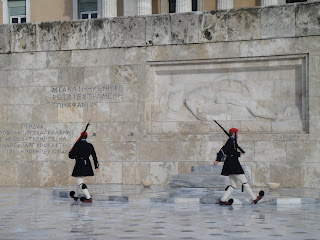The Tower of the Winds, also called horologion (timepiece), is an octagonal Pentelic marble clocktower on the Roman agora in Athens. The structure features a combination of sundials, a water clock and a wind vane.[1] It was supposedly built by Andronicus of Cyrrhus around 50 BC, but according to other sources might have been constructed in the 2nd century BC before the rest of the forum. (Below right)
Greece also has stray dogs and cat Everywhere! The city is their home. They come up and walk with you for a while and then disapear.


Greece also has stray dogs and cat Everywhere! The city is their home. They come up and walk with you for a while and then disapear.


The Monastiraki flea market is the place to be on Sunday when it seems every Athenian is here either buying or selling.Much of the flea market is not really a flea market. It is a collection of small shops of which most of them are tourist shops with the same stuff you will find on Adrianou street in the Plaka.




Me in front of the Parthanon


The name Parthenon refers to the worship of Athena Parthenos, the 'Virgin Athena' who issued fully grown from the head of her father Zeus. The maiden goddess and patroness of Athens, she represents the highest order of spiritual development and the gifts of intellect and understanding. Pure in body, mind and heart, Athena is the symbol of the universal human aspiration for wisdom. It was not only the character and statue of the goddess that symbolized these qualities however, but also the precise topographical location and astronomical orientation of her shrine, and the sacred geometry that infused the entire temple.
The Temple of Athena Nike, on the Nike Bastion of the Acropolis, was constructed in ca. 420 B.C. by the architect Kallikrates. It is built in the Ionic order, and it is amphiprostyle with a row of four columns in front and behind the narrow main cella. Inside the cella would have stood the cult statue of Athena holding a helment in one hand and a pomegranate (symbol of fertility) in the other). The Turks dismantled the temple in 1686, and it has been reassembled twice since then.




The official opening of the New Acropolis Museum took place on 20 June 2009. www.newacropolismuseum.gr/eng
The Temple of Olympian Zeus (Greek: Ναός του Ολυμπίου Διός or Naos tou Olimpiou Dios), also known as the Olympieion, is a colossal ruined temple in the centre of the Greek capital Athens that was dedicated to Zeus, king of the Olympian gods. Construction began in the 6th century BC during the rule of the Athenian tyrants, who envisaged building the greatest temple in the ancient world, but it was not completed until the reign of the Roman Emperor Hadrian in the 2nd century AD some 650 years after the project had begun. During the Roman periods it was renowned as the largest temple in Greece and housed one of the largest cult statues in the ancient world.
The changing of the gaurd at The Tomb of the Unknown soldier- in memory of all the anonymous Greek soldiers the have fallen in the battlefield- in front of the Parliament building.




















No comments:
Post a Comment